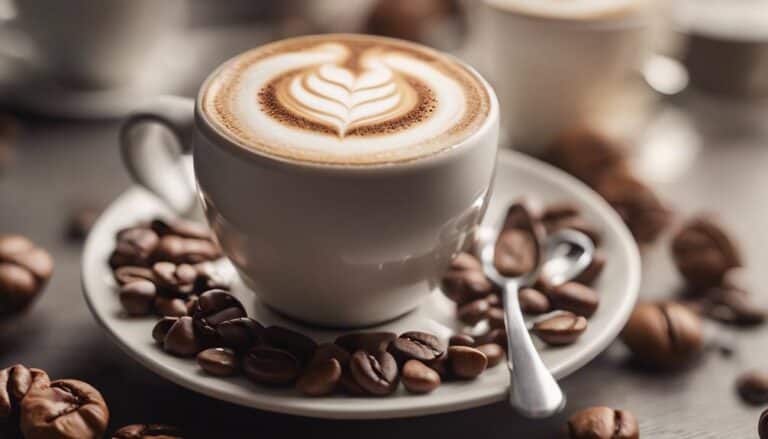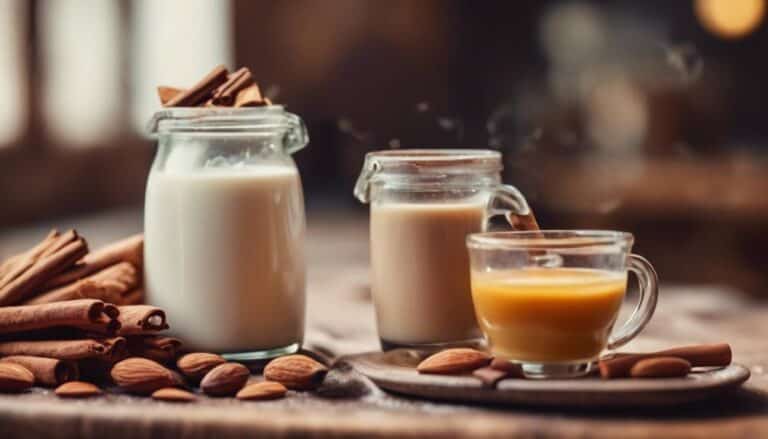What’s the Difference Between a Cappuccino and a Latte? A Clear and Neutral Explanation

If you’re a coffee lover, you’ve probably heard of cappuccinos and lattes. They are two of the most popular espresso drinks in the world, and they are often confused with each other. While they may seem similar, there are some key differences between the two. In this article, we’ll take a closer look at cappuccinos and lattes, and help you understand the differences between them.
Understanding Espresso Drinks Before we dive into the differences between cappuccinos and lattes, it’s important to understand what espresso drinks are. Espresso is a type of coffee that is made by forcing hot water through finely ground coffee beans. Espresso shots are the foundation of most espresso drinks, including cappuccinos and lattes. These drinks are made by adding steamed milk and other ingredients to espresso shots to create unique flavor profiles.
Comparing Cappuccino and Latte Now that we know what espresso drinks are, let’s take a closer look at cappuccinos and lattes. A cappuccino is made by combining equal parts espresso, steamed milk, and milk foam. The milk foam is what sets cappuccinos apart from other espresso drinks. On the other hand, a latte is made by combining espresso shots with steamed milk. Lattes have a smoother texture than cappuccinos, and they are often sweeter due to the added milk.
Key Takeaways
- Cappuccinos are made with equal parts espresso, steamed milk, and milk foam, while lattes are made with espresso shots and steamed milk.
- The milk foam is what sets cappuccinos apart from other espresso drinks.
- Lattes have a smoother texture than cappuccinos and are often sweeter due to the added milk.

Understanding Espresso Drinks
As coffee lovers, we are all familiar with espresso drinks like cappuccinos and lattes. But do we really understand what makes them different from each other? Let’s dive into the world of espresso drinks and explore the nuances that set each one apart.
First things first, what is espresso? Espresso is a concentrated coffee that is brewed by forcing hot water through finely ground coffee beans. It is typically served in small shots and has a strong, bold flavor. Espresso is the foundation of many popular coffee drinks, including cappuccinos and lattes.
An espresso drink consists of a shot of espresso and varying amounts of steamed milk, milk foam, and other flavorings. The amount of each ingredient used determines the type of espresso drink. For example, a cappuccino is made with equal parts espresso, steamed milk, and milk foam, while a latte is made with more steamed milk and a thin layer of foam on top.
To make espresso, you’ll need an espresso machine. Espresso machines use pressure to force hot water through the coffee grounds, creating the concentrated shot of espresso. There are many different types of espresso machines available, ranging from simple manual machines to high-end automatic models.
When it comes to flavor, espresso has a bold, intense taste that is not for the faint of heart. It has a rich, creamy texture and a slightly bitter finish. The flavor of espresso can vary depending on the type of coffee beans used and the brewing method, but it is generally strong and full-bodied.
In conclusion, understanding espresso drinks is essential for any coffee lover. Whether you prefer a cappuccino, latte, or another type of espresso drink, knowing the differences between each one will help you choose the perfect beverage to suit your tastes. So next time you order a coffee, remember that there’s more to it than just a shot of espresso!
What is a Cappuccino?
A cappuccino is a popular Italian coffee beverage that is made from espresso, steamed milk, and milk foam. It is named after the Capuchin friars because the color of the drink is similar to the color of their robes. The cappuccino is a classic coffee drink that has been enjoyed for decades.
Ingredients of a Cappuccino
The ingredients of a cappuccino are simple. A traditional cappuccino is made with a double shot of espresso, steamed milk, and a layer of milk foam on top. The ratio of espresso to steamed milk to milk foam is typically 1:1:1, but this can vary depending on personal preference.
Texture and Flavor of a Cappuccino
The texture of a cappuccino is smooth and velvety. The milk foam on top of the drink gives it a creamy and rich texture. The flavor of a cappuccino is strong and bold, with a slightly sweet taste from the steamed milk. It is a great coffee beverage for those who prefer a stronger coffee flavor.
Cappuccino Variations
There are many variations of the cappuccino. Some popular variations include the dry cappuccino, which has less steamed milk and more foam, and the cappuccino macchiato, which has a splash of milk added to the espresso before the milk foam is added. These variations can be found in most coffee shops and are a great way to try something new.
Cappuccino Preparation
Preparing a cappuccino requires a few key pieces of equipment. A barista will need an espresso machine, a steam wand for steaming the milk, and a pitcher for holding the steamed milk. The double shot of espresso is pulled first, and then the steamed milk is added. Finally, a layer of milk foam is added on top of the drink.
Nutritional Value of a Cappuccino
A cappuccino is a relatively low-calorie coffee beverage. A typical cappuccino made with whole milk contains around 120 calories, 6 grams of fat, and 8 grams of protein. However, the nutritional value can vary depending on the type of milk and sweeteners used. It is important to be mindful of the nutritional value of your cappuccino if you are watching your calorie intake.

What is a Latte?
A latte is a popular milky coffee beverage that originated in Italy and is now enjoyed worldwide. It is made with a shot of espresso, steamed milk, and a layer of milk foam on top. Lattes are known for their smooth and creamy texture and subtle coffee flavor.
Ingredients of a Latte
The basic ingredients of a latte are espresso, steamed milk, and milk foam. Espresso is a concentrated coffee that is made by forcing hot water through finely ground coffee beans. Steamed milk is heated milk that is aerated with steam to create a smooth and creamy texture. Milk foam is created by aerating the milk further, resulting in a layer of froth on top of the drink.
Texture and Flavor of a Latte
Lattes are smooth and creamy in texture, with a subtle coffee flavor that is complemented by the sweetness of the steamed milk. The milk foam on top adds a light and airy texture to the drink. Lattes can be customized with flavored syrups or spices to enhance the flavor profile.
Latte Variations
Lattes can be made with different types of milk, such as almond, soy, or oat milk, to accommodate dietary restrictions or personal preferences. They can also be served hot or cold, with or without flavorings, and can be customized with latte art.
Some popular latte variations include:
- Iced latte
- Mocha latte
- Vanilla latte
- Pumpkin spice latte
Latte Preparation
Lattes are typically prepared by a barista in a coffee shop using an espresso machine and steaming wand. The espresso is pulled into a cup, and steamed milk is added to create the desired ratio of coffee to milk. The milk foam is then added on top, and the drink can be customized with flavorings or toppings.

Nutritional Value of a Latte
Lattes are a good source of calcium and protein, but can also be high in calories and fat depending on the type of milk and flavorings used. A typical 12-ounce latte made with whole milk contains around 150 calories, 6 grams of fat, and 8 grams of protein. It is important to consider the nutritional value of a latte when incorporating it into a balanced diet.
Comparing Cappuccino and Latte
Comparison in Ingredients
Cappuccino and latte are two popular espresso-based drinks that differ in their ingredients. A cappuccino is traditionally made using equal parts espresso, steamed milk, and milk foam, while a latte involves adding steamed milk to an espresso. The milk used in cappuccinos is typically whole milk, while lattes can be made with any type of milk, such as almond or soy milk.
Comparison in Texture and Flavor
The texture and flavor of cappuccinos and lattes also differ. Cappuccinos are known for their layered design, with the espresso at the bottom, steamed milk in the middle, and milk foam on top. This creates a strong, bold flavor with a creamy and frothy texture. In contrast, lattes have a milder flavor with a smoother and creamier texture. The milk in lattes is mixed with the espresso, creating a uniform texture throughout the drink.
Comparison in Preparation
The preparation of cappuccinos and lattes also differs. Cappuccinos are typically prepared by baristas who are skilled in creating the layered design. The milk is steamed to create a thick and creamy foam, which is then poured onto the espresso in a specific design. Lattes, on the other hand, are easier to prepare and can be made at home. The milk is simply steamed and mixed with the espresso, without the need for a specific design.
Comparison in Nutritional Value
Cappuccinos and lattes also differ in their nutritional value. Cappuccinos generally have fewer calories than lattes, as they contain less milk. A typical cappuccino contains around 120 calories, while a latte can contain up to 300 calories or more, depending on the type of milk used. Cappuccinos also tend to have a higher caffeine content than lattes, as they contain less milk.
In terms of protein and fat content, both cappuccinos and lattes contain similar amounts. However, if you are looking for a healthier option, cappuccinos may be a better choice due to their lower calorie and fat content.
Overall, the choice between cappuccinos and lattes comes down to personal preference. If you prefer a stronger, bolder flavor with a creamy and frothy texture, a cappuccino may be the way to go. If you prefer a milder flavor with a smoother and creamier texture, a latte may be more your style.
Additional Information
Coffee Shop Terminology
When you go to a coffee shop, you’ll often hear different terms for coffee drinks. It’s important to understand these terms so you can order the drink you want. Cappuccinos and lattes are both espresso-based drinks that are made with steamed milk, but the proportions of espresso, steamed milk, and frothed milk differ.
A cappuccino is typically made with equal parts espresso, steamed milk, and frothed milk. It has a frothy texture and is often served in a smaller cup. A latte, on the other hand, has more steamed milk and less frothed milk. It has a velvety texture and is often served in a larger cup.
Adding Flavors and Sweeteners
If you like your coffee sweet or flavored, you can add syrups, sweeteners, or cocoa powder to your cappuccino or latte. Popular flavors include caramel, peppermint, and chocolate. You can also add lavender syrup for a unique twist.
When adding sweeteners or flavors, it’s important to consider the proportions. Too much sweetener can overpower the taste of the coffee, while too much flavoring can make the drink taste artificial. A good rule of thumb is to start with a small amount and add more if needed.
Making Coffee at Home
If you want to make cappuccinos or lattes at home, you’ll need an espresso machine and a milk frother. You can also use a whisk to froth the milk by hand, but it may take longer.
To make a cappuccino, start by pulling a shot of espresso. Then, steam equal parts milk and froth it using the steam wand. Pour the milk and froth into the espresso and spoon the remaining froth on top.
To make a latte, pull a shot of espresso and steam the milk until it has a velvety texture. Pour the steamed milk into the espresso and spoon a small amount of froth on top.
Here’s a quick chart to summarize the differences between cappuccinos and lattes:
| Drink | Espresso | Steamed Milk | Frothed Milk |
|---|---|---|---|
| Cappuccino | Equal parts | Yes | Yes |
| Latte | More than cappuccino | Yes | No |
Remember, making coffee drinks takes practice, so don’t be discouraged if your first attempts don’t turn out perfectly. With a little patience and practice, you can master the art of making cappuccinos and lattes at home.





